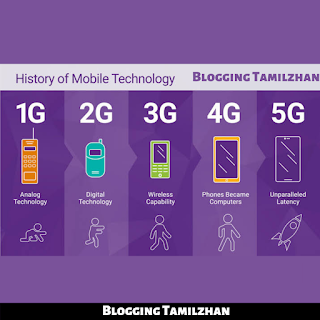4G vs 5G, evaluation of the Networks
 |
| 4G vs 5G |
4g vs 5g. In this blog post, we going to see about the 4g and 5g, differences between them, and we going to learn about the evaluation of the networks 1G to 4G, and you can translate this blog into Tamil using google translater. So let's jump into the content.
Hey, guys welcome to this session on 4g vs 5g by bloggingtamilzhan now before we begin the session. Every decade the cellular industry performs a major upgrade to its wireless infrastructure the 2000s were dominated by 3g while mobile phones in the last decade ran on 4g almost every person is online right now either on desktop or mobile phones the comfort and accessibility of mobile applications are the main reason why people are opting for mobile over desktop in 2018 the number of mobile apps downloaded worldwide was 205.4 billion which is expected to reach 258.2 billion by 2022. with an increase in internet usage requirement for internet speed increased as well
1. 1G technology :
So let's start with 1g it was between 1987 to 1991. engineer Neil Papworth sent the first SMS on December 3rd, 1992. When he wrote about merry Christmas on a computer and sent it to the cell phone of Vodafone director Richard Jarvis inception of amps technology from the pre-existing inps transition connectivity established seamlessly on mobile connectivity introducing mobile voice services 1g introduced analog wise.
Mistakes :
So what went wrong here 1g had very poor voice quality with the poor battery life the size of the phone was very large without any security it had limited capacity and very poor reliability.
2. 2G technology :
So after that came 2g era that was 1991 to 2001. 2g was the first wireless digital transmission in 1991. gsm that's global systems for mobile communication-enabled data transfer on the top voice at a speed of 30 to 35 kbps 2g was developed primarily to transfer voice fax MMS and SMS services by use of digital voice compression the time standards support three times as many voice channels in the same bandwidth as the old analog systems data was responsible for the constant spike in revenues in telecom operators in addition to the voice revenues. 40 of the revenues was collected for data 2.5 g for the introduction of GPRS as enhanced data services GPRS can be viewed as a boost data service for gsm users but using them switching and multiplexing techniques the maximum transfer speed that can be reached via GPRS is approximate 170kbps 2.75 g saw the entry of edge data transmission rate saw 4 times increase from 170 kbps to 500 kbps, in theory, it was said to be 1 Mbps edge transfers data in few seconds if we compare it with GPRS technology, for example, a typical text file of 40 kb was transferred in only two seconds as compared to transfer from GPRS technology which was 6 seconds.
Mistakes :
So what went wrong here 2g required strong digital signals to help mobile phones work if there was no network coverage digital strengths were weakened systems were unable to handle complex data like videos.
3. 3G technology :
As the generation moved towards 3g the user requirement was too complex for 2g to satisfy and then came the 3g era that was 2001 to 2009. 3g network was introduced in 1998 we saw its establishment in the early 2000s the max speed of 3g was estimated to be around 2 Mbps for stationary devices and 384 kbps in mobile phones the theoretical max speed was 21.6 Mbps it was based on CDMA 2000 and edge technologies 3g introduced media streaming as well data in 3g was broken down into small pieces of packets and then sent to the destination unlike 2g which used circuit switching this was revolutionary as users paid only for the data they spent rather than the time spent online multimedia, navigation, mobile apps, browsers, conference calls, mobile, tv all saw their inception for the early 3g era 5g was conceptualized and released with HSPA making the iconic edge symbol on the mobile network it was all about data in 3.5 g where data transmission rates went up to 14 Mbps 3.75 g saw the release of h plus symbol on the network data speeds went up even further with a maximum speed of 42 Mbps
Mistakes :
So what went wrong in 3g it was a messy architecture demand of 3g compatible handsets were very less cost of upgrading to 3g device was way too high and the power consumption was high when your internet is on.
4. 4G technology :
Then came the 4g era that was from 2010 to 2019. 4g saw an overlap of itself with 3g as in 2008 4g technology started to roll out but had issues to commercially announce the communication system as 4g due to minimum standard requirements which were not fulfilled the speed of 3g quickly became insufficient as technology and smartphones evolved resulting in heavier files and bulkier data flows it provided a quality that enriched user experience and advanced gaming series hd, mobile, tv video conferencing 3d tv ip telephony and other services that demanded higher speeds with the implementation of 4g some 3g features were removed such as radio spectrum technology 4g lte that means long term evolution was a complete redesign and simplification of 3g network architecture resulting in a significant reduction in transfer latency and thus increasing efficiency and speeds on the network users encountered a problem in accessing data while on a voice call with 4g lte hence inception of 4g volt which simplified voice over lte enabling users to access 4g data and still be able to make calls 4g carries 3 times the data 3g carried and 6 times the data 2g gsm network carried.
Mistakes :
So what went wrong here 4g LTE network needed more complex hardware 4g technology uses many antennae and transmitters resulting in poor battery life in areas without 4g coverage customers downgraded to 3g while still paying the cost of 4g there was a very high data consumption when we used 4g data.
5. 5G technology :
Then came the 5g era that was 2019 and beyond 5g looks at us with a new experience in faster data rates higher connection density much lower latency among other improvements 5g is not an upgrade to 4g but in a league of its own because it provides us a ability to connect thousands of devices at once giving the user the true sense of real-time experience this means the computing and processing can move to the cloud and result in smarter iot devices reducing the cost of manufacturing and maintenance by optimizing the network for the telecom operator 5g technology may use a variety of spectrum bands including millimeter wave radio spectrum which can carry very large amounts of data to a very short distance 5g mobile technology can user in new immensive processes such as ar and vr which is much faster more uniform data rates lower latency and lower cost per bit 5g can enable new services that can perform industries with ultra reliable available low latency links that can remote control of critical infrastructure vehicles and medical procedures as per qualcomm 5g will extend its arms out into the enterprise and will see massive growth 5g is driving growth globally 13.2 trillion dollars of global economic output was done 22.3 million new jobs were created because of 5g 2.1 trillion dollars was there in gdp growth of the world
4G vs 5G
 |
| 4G vs 5G |
Now we come to our last topic which is the difference between 4g and 5g the key difference between 4g and 5g is speed. 5g is expected to be much faster than 4g while offering lower latency and better bandwidth even the cellular infrastructure that enables wireless communication gets upgraded roughly around every 10 years currently 5g is slowly replacing 4g around the world there are a lot of predictions going on beyond 5g but one thing is for sure there is a bright future in the telecom industry because electronic devices will continue to grow and faster internet will be required.
Thank you😍😍😍


.png)











0 Comments